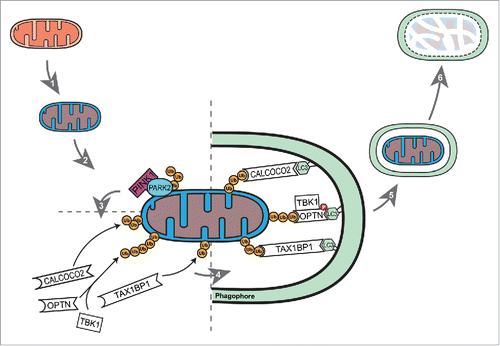Figures & data
Figure 1. Mitophagy receptors are dynamically recruited to damaged mitochondria in response to PINK1- and PARK2-induced ubiquitination, leading to sequestration of the organelle by an LC3-positive phagophore. (1) An individual mitochondrion is acutely damaged. (2) The damaged mitochondrion is ubiquitinated through the action of Parkinson disease-linked proteins PINK1 and PARK2. (3) Within 15 min of PARK2-dependent ubiquitination, OPTN and its upstream kinase TBK1 are corecruited to the damaged mitochondrion. Simultaneously, autophagy receptors CALCOCO2 and TAX1BP1 translocate to the mitochondrial outer membrane. (4) Upon TBK1 phosphorylation, OPTN, associates with LC3, inducing autophagic engulfment of the damaged organelle. In the absence of TBK1 activity, CALCOCO2 can promote mitophagy. (5) Within 45 min of the initial injury, the damaged mitochondrion is sequestered within an autophagosome and functionally separated from the cytosol. (6) Over several hours, the mitochondrion is degraded within an autolysosome. Whereas Parkinson disease-linked mutations in PARK2 interfere with ubiquitination of damaged mitochondria, ALS-linked mutations in TBK1 and OPTN interfere with the subsequent recruitment of autophagy receptors and LC3-positive membranes.

